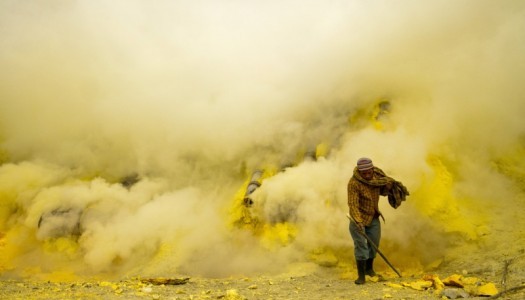On March 28, the UMass Boston Film Series screened Sasha Friedlander’s “Where Heaven Meets Hell.” The film follows four workers in the sulfur mines of Kawah Ijen through their daily lives, documenting the horrific conditions under which they work, following them into mud huts they share with their families and livestock.
Friedlander visited Kawah Ijen in 2009, while employed by the Bali Post. While she planned to film the documentary as soon as she saw the miners climbing the side of an active volcano before dawn, she didn’t make it back until two years later.
“Where Heaven Meets Hell” was filmed in 2011, in two separate installments that both lasted for months. The filmmakers lived with and among their subjects, meeting their children and wives.
The movie has four main characters: Anto, a man whose raw intelligence makes him fit for better work but who lacks the high school diploma required by almost all employers; Purnomo, a cheerful young man who has developed a constant hacking cough due to exposure to the sulfur; Sukarman, who loans his daughter money to start a corner store; and Hadis, who is working to send his girl to school.
The injustices laid bare in the course of the film are familiar to thinking Americans. Some Indonesian men spend weeks at a time away from home, working backbreaking jobs that eventually leave them unable to breathe, for far below a living wage. They mine sulfur, which is used to process sugar, which the same thinking Americans are unlikely to go without even after listening to Purnomo cough.
The men in the movie are very human. They are not ignorant or unaware. They are not pitiful, and they are certainly not mute. Exploitation of workers in poorer countries is unlikely to end; our world is such that it cannot end.
It is difficult to find clothes that weren’t made in sweatshops, or candy made from ethically and sustainably sourced ingredients. When fair trade items are available, they may also be prohibitively expensive. Friedlander’s film will not change this.
But it does change the way we often talk about exploited peoples in this country, as if they were mute objects to pity.
The dignity and tenacity of the workers from Kawah Ijen is striking. These are men who carry up to 200 lbs of sulfur on their shoulders all day. It would be understandable to collapse after dinner, but instead they teach themselves French from old books.
It is impossible not to feel that their very lives are tenuous, that Anto might starve or that Sukarman might fall into the crater or that Purnomo might simply stop breathing. It is impossible not to sympathize with them as they struggle. Most importantly, it is impossible not to like the men who work at Kawah Ijen.

